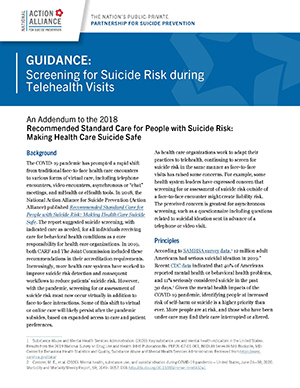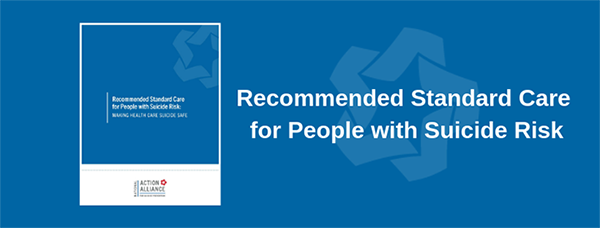Standard Care
"We should treat suicide prevention in health care systems as we treat heart attack prevention." - Recommended Standard Care for People with Suicide Risk: Making Health Care Suicide Safe, National Action Alliance for Suicide Prevention
When a person with symptoms of a possible heart attack reaches the emergency room, medical staff know exactly what they need to do to assess this risk and respond. The same is not always true for a person who may be at risk for suicide.
Although we know what works in suicide prevention and suicide care, much of this knowledge is not being translated into practice at health systems across the country. The Action Alliance is committed to advancing the widespread adoption of these evidence-based practices as the standard care for suicide risk.
Recommended Standard Care Report
To advance progress in this area, the Action Alliance (Recommended Standard Care Work Group) developed Recommended Standard Care for People with Suicide Risk: Making Health Care Suicide Safe. Released in 2018, the report described the basic elements of suicide care that should be standard in health care settings.
The report presents specific recommendations for four settings:
- Primary care
- Outpatient behavioral health care (mental and/or substance use treatment)
- Emergency department
- Inpatient behavioral health care (hospital level psychiatric or addiction treatment)
Telehealth and Suicide Risk
 To support the rapid shift to telehealth services in 2019, the Action Alliance produced Guidance: Screening for Suicide Risk during Telehealth Visits. This supplement to the 2018 Recommended Standard Care for People with Suicide Risk: Making Health Care Suicide Safe provides standard care recommendations regarding screening for suicide risk during telehealth visits.
To support the rapid shift to telehealth services in 2019, the Action Alliance produced Guidance: Screening for Suicide Risk during Telehealth Visits. This supplement to the 2018 Recommended Standard Care for People with Suicide Risk: Making Health Care Suicide Safe provides standard care recommendations regarding screening for suicide risk during telehealth visits.
“Asking about suicidal ideation or behavior can accurately identify people at risk, and the evidence is clear that inquiring about suicidal ideation or behavior does not create or increase risk. Importantly, lifesaving interventions and clinical care are impossible to render if potential suicide risk remains unknown.”
To support the adoption of standard suicide risk screening practices, the Action Alliance also developed the following videos:
- The Importance of Screening for Suicide Risk in Telehealth
This brief video discussed the importance of suicide risk screening and safety planning in telehealth services. - Telehealth: Screening for Suicide Risk – Practical Tips and Best Practices
The video provided practical suggestions for setting up virtual screening within an electronic health record portal and steps to take when risk is present. - Telehealth: Including Family or Other Support People
This video showcased a panel of subject matter experts who highlighted the importance of involving family and supportive others in telehealth services, offered practical suggestions to involve family and supportive others, and shared how to manage privacy implications. - Telehealth: Reducing Liability in Suicide Care
This video discussed the best practices that reduce liability when providing telehealth care for patients with suicide risk.
